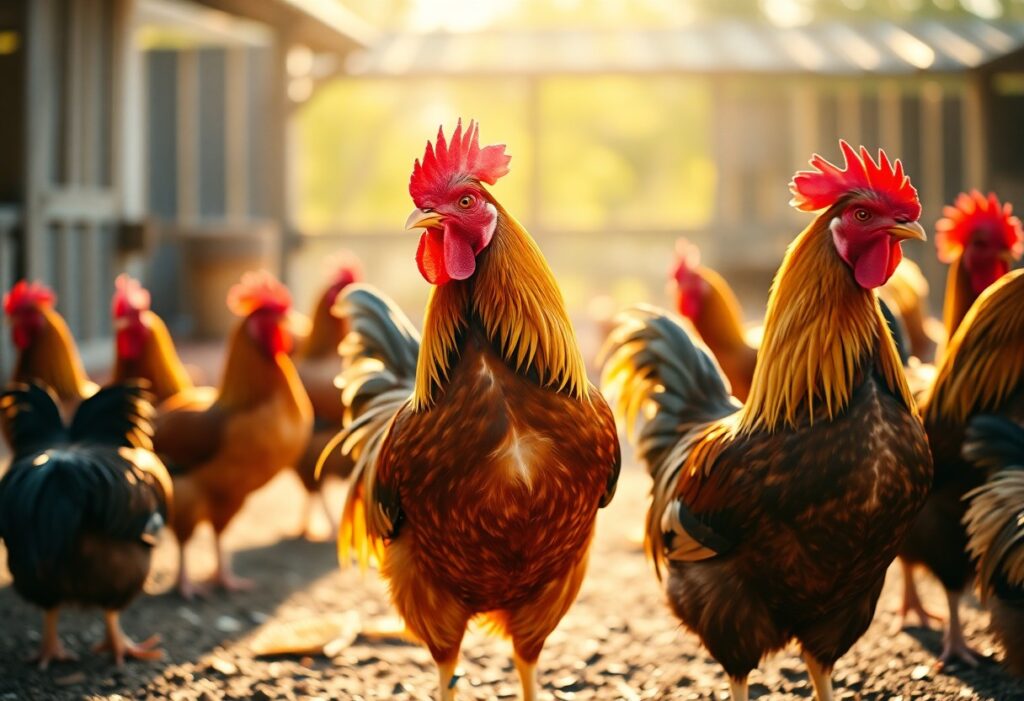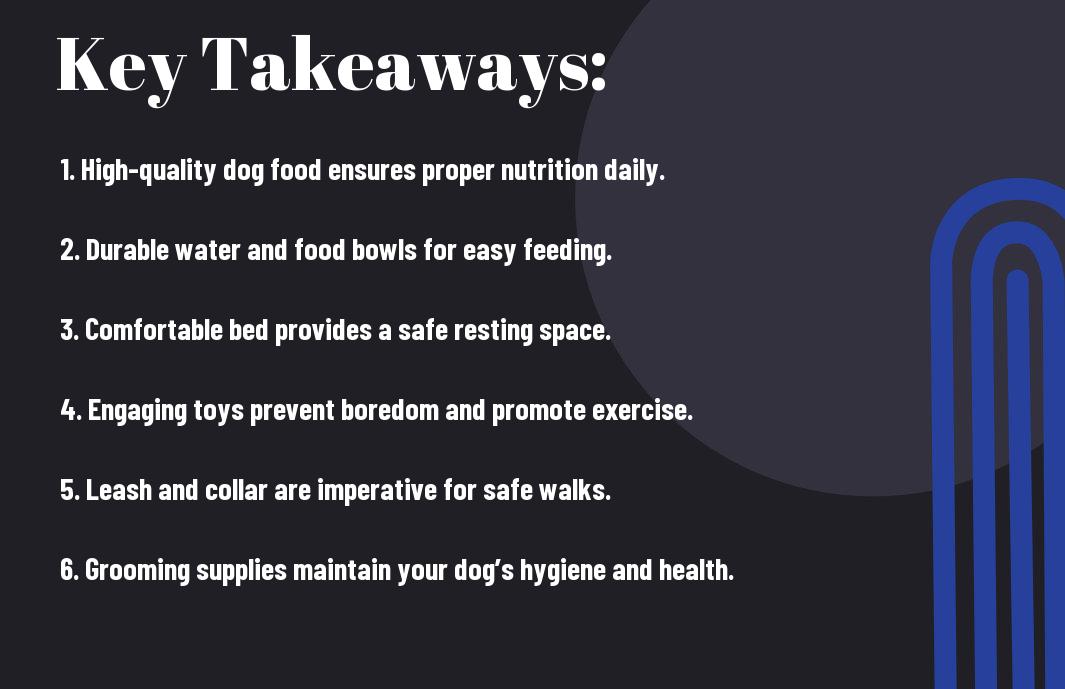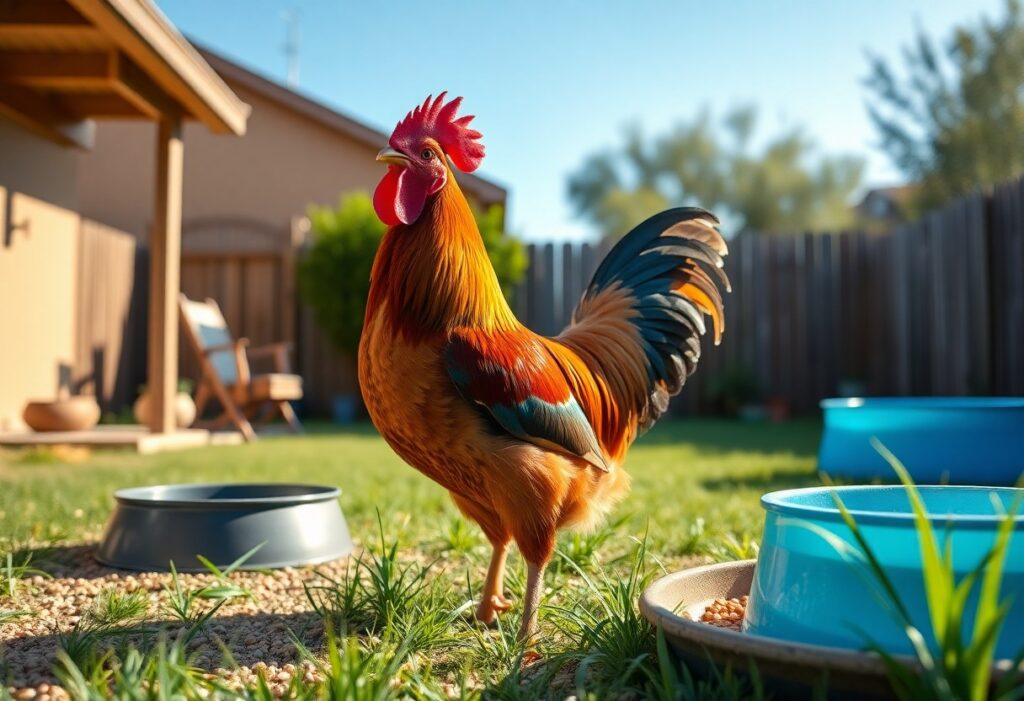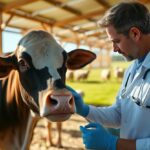Many aspiring poultry keepers overlook the significance of rooster behavior as an indicator of your flock’s overall health. Understanding these behaviors not only helps you foster a harmonious environment but also enables you to identify when your roosters might be facing stress or health issues. From their daily routines to social interactions, paying close attention to your roosters can empower you in maintaining their well-being and enhancing the productivity of your yard. Explore how you can interpret their actions to support their health and happiness effectively.
Key Takeaways:
- Rooster behavior can reflect their overall health; symptoms like lethargy or aggression may indicate underlying health issues.
- Observing social interactions among roosters can help identify stress levels and establish a well-balanced flock environment.
- Nutritional needs and proper living conditions play a significant role in promoting healthy behaviors and preventing health complications in roosters.

The Importance of Rooster Behavior
Your rooster’s behavior is a vital indicator of his overall health and well-being. Observing how your rooster interacts with his environment can provide insights into potential health issues and help you ensure he remains lively, active, and healthy. By understanding these behavior patterns, you can better manage your flock and ensure a harmonious and productive environment.
Signs of Healthy Rooster Behavior
Any healthy rooster will exhibit signs such as active crowing, foraging energetically, and maintaining a harmonious relationship with hens and other flock members. You should also look for a rooster that stands tall with a good posture, displays a vibrant plumage, and shows curiosity about his surroundings. These behaviors indicate not only physical health but also good mental and social status within the flock.
Behavioral Changes Linked to Health Issues
Before considering the health of your rooster, it’s vital to recognize when his behavior changes significantly. Common behavioral changes can include withdrawal, reduced activity, or aggressiveness. Noticing these signs early allows you to take prompt action, addressing potential health concerns before they escalate.
At times, your rooster may show symptoms indicating serious health issues, such as a sudden decrease in appetite, unusual vocalizations, or reluctance to interact with other chickens. Aggressiveness or territorial behavior may also signal underlying health problems or stress. If you observe any of these changes, it’s imperative to consult a veterinarian for a thorough examination and guidance on how to address these issues promptly, ensuring the well-being of your rooster and the overall harmony of your flock.
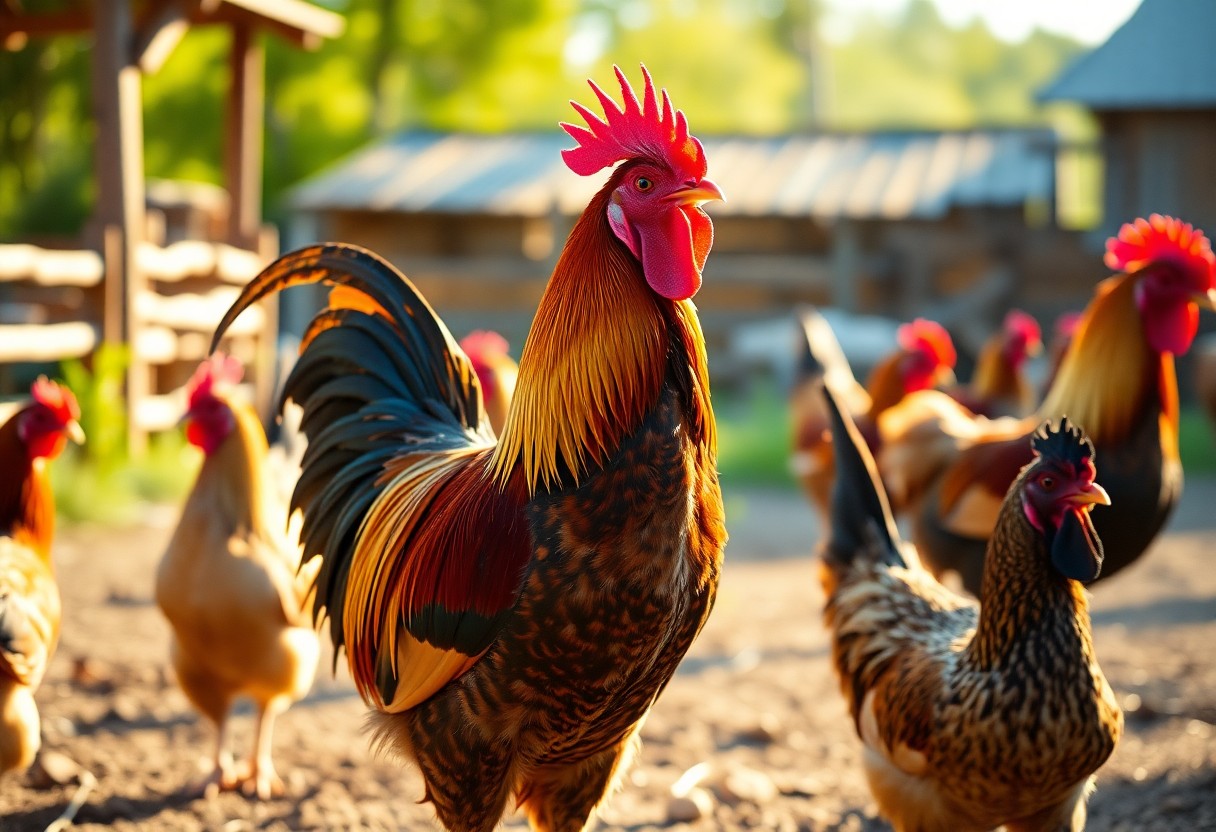
Social Structure and Hierarchy
The social structure of roosters is vital for maintaining harmony within the flock. Understanding their hierarchy can help you foster a healthier environment where each bird knows its place. This hierarchy regulates interactions, feeding, and nesting, which are important for your roosters’ overall well-being.
Understanding Pecking Order
Pecking order refers to the social ranking among your roosters, determining who has access to food, mates, and space. Established early on, this hierarchy can shift with changes in the flock, affecting interactions. By observing these dynamics, you can ensure a balanced environment that minimizes conflict.
Impact of Stress on Rooster Behavior
About stress can significantly alter your rooster’s behavior. Elevated stress levels may lead to aggression, decreased appetite, and even health issues. Identifying and mitigating stressors is vital for maintaining the stability of your flock.
Plus, reducing stress in your flock can lead to improved social dynamics and overall health. You can achieve this by ensuring sufficient space, proper nutrition, and a peaceful environment. High-stress levels will lead to a decline in health, increased aggression, and potential injuries among your roosters. By actively managing these factors, you foster a more harmonious social structure, which ultimately benefits the well-being of your roosters.
Communication Among Roosters
Once again, understanding the various ways roosters communicate can significantly enhance your knowledge about their behavior and overall well-being. Roosters employ a combination of vocalizations and body language to express their feelings, establish dominance, and interact with their flock. By paying attention to these communication methods, you will be better equipped to respond to their needs and maintain a harmonious environment in your backyard or farm.
Vocalizations and Their Meanings
Below are some common vocalizations made by roosters and what they signify. The classic crowing heralds daylight and serves as a territorial claim. A series of clucks may indicate the presence of food, while a softer purring sound often signifies contentment. You should also be alert to distress calls, which can indicate threats or discomfort among your flock members.
Body Language Indicators
Among the visual cues that roosters use, body language plays a vital role in their communication. When you observe a rooster standing tall with an elevated posture, it often signals confidence and dominance. Conversely, ruffled feathers and a crouched position can indicate fear or submission. A rooster that spreads its wings and shakes its feathers is displaying aggression and a challenge to other roosters.
To further understand body language indicators, you should pay close attention to tail positioning and movement. A rooster with a high, upright tail is generally confident and assertive, while a drooped tail can signify stress or submission. If you notice your rooster pacing or engaging in a series of aggressive movements, it might be trying to establish dominance over others. In contrast, a rooster that approaches the flock calmly, without puffing out his chest or adopting an aggressive stance, is likely promoting peace and camaraderie within the group. By recognizing these signals, you can maintain a safer and healthier environment for your flock.

Impact of Environment on Behavior
Keep in mind that your rooster’s environment plays a significant role in shaping his behavior. Factors such as space, safety, and cleanliness can significantly influence not only his mood but also his overall health. A well-maintained environment allows for natural behaviors like foraging, dust bathing, and socializing, all of which are important for your rooster’s well-being.
Habitat Requirements for Healthy Behavior
Below are several habitat requirements that you need to consider for fostering healthy behavior in your rooster. He requires sufficient space to roam and engage in natural behaviors, a clean area to prevent disease, and access to food and water. Providing a sheltered environment will also protect him from harsh weather conditions and potential predators, promoting a happy and healthy life.
Effects of Socialization and Interaction
About your rooster’s interactions with both humans and other chickens, socialization plays a vital role in his behavior. Roosters that receive regular interaction and positive reinforcement tend to be more confident and less aggressive. It’s important for you to spend time with your rooster, as this can help him feel secure and decrease stress levels.
Consequently, the quality of social interactions your rooster experiences significantly impacts his behavioral traits. Regular interactions can enhance his social confidence and reduce instances of aggression or fearfulness. Conversely, isolation might lead him to develop stress-related behaviors, such as feather picking or excessive crowing. Engaging with your rooster and allowing him to socialize with others will not only enhance his behavior but also contribute positively to his mental health and overall well-being.
Nutrition and Its Influence on Behavior
Now, understanding the relationship between nutrition and rooster behavior is key to maintaining a healthy flock. A well-balanced diet not only supports physical development but also plays a significant role in your rooster’s temperament and overall mood. When nutritional needs are met, your roosters are more likely to exhibit calm, social behaviors, whereas deficiencies can lead to stress or aggression.
Diet Essentials for Optimal Health
Along with providing a balanced blend of grains, seeds, and greens, it’s important to incorporate minerals and vitamins into your rooster’s diet. Adequate protein levels are also important for muscle development and feather maintenance. Ensuring that your roosters have access to clean water further enhances nutrient absorption and overall well-being.
Behavior Changes Due to Nutritional Deficiencies
On the contrary, malnutrition can severely impact your roosters’ behavior. Inadequate intake of important nutrients can result in irritability, lethargy, and aggression. Conversely, feeding your roosters a balanced diet will encourage positive social interactions and a healthier living environment.
For instance, a deficiency in vitamin A can lead to poor vision and increased pecking behavior, while a lack of calcium may cause restlessness and aggression among roosters as they compete for resources. Low protein intake can result in weakened feathering and low energy, making your roosters more prone to stress. By ensuring a proper diet, you help your roosters maintain not just their physical health but also a stable and positive demeanor, thus contributing to a harmonious flock environment.
Tips for Observing Rooster Behavior
All rooster owners can benefit from knowing what to look for when assessing their birds’ health. Pay close attention to their interactions, vocalizations, and overall demeanor. Here are some tips to guide your observations:
- Watch for changes in social behavior
- Listen for different types of vocalizations
- Observe their feeding and grooming habits
- Look for signs of aggression or submission
This proactive approach will help you ensure your rooster stays healthy and well-adjusted.
Key Behaviors to Monitor
After observing your rooster, it’s vital to identify key behaviors that can indicate their overall health. Look for signs of activity like scratching, dust bathing, and foraging, as these behaviors reveal their energy levels and mental stimulation. Changes in these patterns often signal possible health issues that deserve your attention.
When to Consult a Veterinarian
Rooster health concerns can arise unexpectedly, making it vital for you to know the warning signs. If your rooster displays any unusual behaviors, such as excessive lethargy, loss of appetite, or difficulty breathing, it’s vital to seek veterinary advice quickly. Prompt action can make a significant difference in your bird’s recovery.
And when you notice drastic behavioral changes or signs of acute distress, do not hesitate to consult a veterinarian. Other concerning signs include persistent coughing, unusual droppings, or limping. These symptoms may indicate underlying issues that require professional intervention. Quick diagnosis and treatment can help prevent complications and ensure your rooster remains happy and healthy.
Final Words
Now that you have a deeper understanding of rooster behavior and its connection to their overall health, you can observe your flock more effectively. By recognizing signs of stress or illness through their actions, you can take proactive steps to ensure their well-being. This knowledge will empower you to create a healthier environment, leading to happier, more productive roosters. By paying attention to their behavior, you enhance not only their lives but also the success of your poultry endeavors.
FAQ
Q: What are the common behaviors exhibited by roosters, and how do they signal their health status?
A: Roosters display several behaviors that can indicate their health. For example, a healthy rooster often engages in crowing, which is a normal part of their social behavior. Active grooming, such as preening their feathers, also demonstrates good health as it shows they are comfortable and have energy. Additionally, a rooster’s interest in foraging for food and interacting with hens indicates a healthy appetite and overall wellbeing. If a rooster is lethargic, stops crowing, or avoids social interactions, it may be a sign of illness or distress.
Q: How does a rooster’s social behavior impact its health and that of the flock?
A: A rooster plays a vital role in the social hierarchy of a flock. Healthy social interactions can reduce stress levels, which positively impacts overall health for both the rooster and the hens. Roosters establish a pecking order, and their protective behaviors, such as alerting the flock to potential threats, are necessary for maintaining the wellbeing of the group. Conversely, if a rooster is overly aggressive or isolated, it can lead to increased stress among the hens, which may result in lower egg production and increased illness within the flock.
Q: What signs should I look for to assess if my rooster’s behavior is abnormal and what might it indicate about their health?
A: Observing a rooster’s behavior for any changes is important for assessing health. Signs of abnormal behavior include prolonged aggression, excessive crowing, or a lack of interest in food and social interactions. If a rooster suddenly becomes withdrawn or shows signs of distress, such as excessive feather pecking or isolation from the flock, it may indicate physical issues like disease or parasites. Other red flags include changes in droppings, lethargy, or changes in vocalization patterns. Quick recognition of these behaviors can help in taking timely action to ensure their health is maintained.
